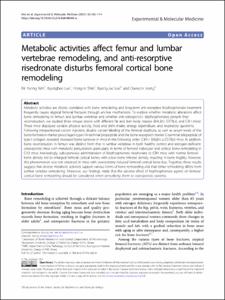KUMEL Repository
1. Journal Papers (연구논문)
1. School of Medicine (의과대학)
Dept. of Orthopedic Surgery (정형외과학)
Metabolic activities affect femur and lumbar vertebrae remodeling, and anti-resorptive risedronate disturbs femoral cortical bone remodeling
- Keimyung Author(s)
- Lee, Kyung Jae
- Department
- Dept. of Orthopedic Surgery (정형외과학)
- Journal Title
- Experimental and Molecular Medicine
- Issued Date
- 2021
- Volume
- 53
- Issue
- 1
- Abstract
- Metabolic activities are closely correlated with bone remodeling and long-term anti-resorptive bisphosphonate treatment frequently causes atypical femoral fractures through unclear mechanisms. To explore whether metabolic alterations affect bone remodeling in femurs and lumbar vertebrae and whether anti-osteoporotic bisphosphonates perturb their reconstruction, we studied three mouse strains with different fat and lean body masses (BALB/c, C57BL6, and C3H mice). These mice displayed variable physical activity, food and drink intake, energy expenditure, and respiratory quotients. Following intraperitoneal calcein injection, double calcein labeling of the femoral diaphysis, as well as serum levels of the bone-formation marker procollagen type-I N-terminal propeptide and the bone-resorption marker C-terminal telopeptide of type-I collagen, revealed increased bone turnover in mice in the following order: C3H > BALB/c ≥ C57BL6 mice. In addition, bone reconstitution in femurs was distinct from that in lumbar vertebrae in both healthy control and estrogen-deficient osteoporotic mice with metabolic perturbation, particularly in terms of femoral trabecular and cortical bone remodeling in CH3 mice. Interestingly, subcutaneous administration of bisphosphonate risedronate to C3H mice with normal femoral bone density led to enlarged femoral cortical bones with a low bone mineral density, resulting in bone fragility; however, this phenomenon was not observed in mice with ovariectomy-induced femoral cortical bone loss. Together, these results suggest that diverse metabolic activities support various forms of bone remodeling and that femur remodeling differs from lumbar vertebra remodeling. Moreover, our findings imply that the adverse effect of bisphosphonate agents on femoral cortical bone remodeling should be considered when prescribing them to osteoporotic patients.
- Keimyung Author(s)(Kor)
- 이경재
- Publisher
- School of Medicine (의과대학)
- Citation
- Mi Yeong Kim et al. (2021). Metabolic activities affect femur and lumbar vertebrae remodeling, and anti-resorptive risedronate disturbs femoral cortical bone remodeling. Experimental and Molecular Medicine, 53(1), 103–114. doi: 10.1038/s12276-020-00548-w
- Type
- Article
- ISSN
- 2092-6413
- Source
- https://www.nature.com/articles/s12276-020-00548-w
- Appears in Collections:
- 1. School of Medicine (의과대학) > Dept. of Orthopedic Surgery (정형외과학)
- 파일 목록
-
-
Download
 oak-2021-0010.pdf
기타 데이터 / 2.49 MB / Adobe PDF
oak-2021-0010.pdf
기타 데이터 / 2.49 MB / Adobe PDF
-
Items in Repository are protected by copyright, with all rights reserved, unless otherwise indicated.